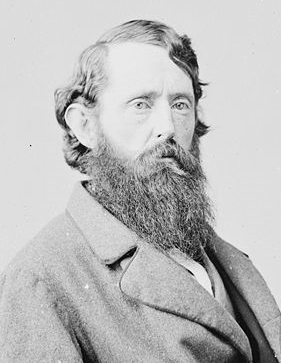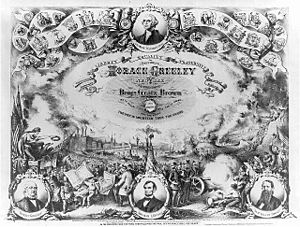Benjamin Gratz Brown facts for kids
Quick facts for kids
Benjamin Gratz Brown
|
|
|---|---|
 |
|
| 20th Governor of Missouri | |
| In office January 4, 1871 – January 3, 1873 |
|
| Lieutenant | Joseph J. Gravely |
| Preceded by | Joseph W. McClurg |
| Succeeded by | Silas Woodson |
| United States Senator from Missouri |
|
| In office November 13, 1863 – March 3, 1867 |
|
| Preceded by | Robert Wilson |
| Succeeded by | Charles D. Drake |
| Personal details | |
| Born | May 28, 1826 Frankfort, Kentucky, U.S. |
| Died | December 13, 1885 (aged 59) Kirkwood, Missouri, U.S. |
| Political party | Democratic (Before 1854, 1872–1885) Republican (1854–1870) Liberal Republican (1870–1872) |
| Other political affiliations |
Unconditional Union (1860–1866) Radical Republican |
| Spouse |
Mary Gunn
(m. 1858) |
| Relatives | Mason Brown (father) Montgomery Blair (cousin) Margaret Wise Brown (granddaughter) |
| Education | Transylvania University Yale University (BA) University of Louisville (LLB) |
| Military service | |
| Allegiance | |
| Branch/service | Union Army |
| Years of service | 1861–1863 |
| Rank | |
| Battles/wars | American Civil War |
Benjamin Gratz Brown (May 28, 1826 – December 13, 1885) was an important American politician. He served as a U.S. Senator and was the 20th Governor of Missouri. He also ran for Vice President in the 1872 election. He was part of the Liberal Republican and Democratic Party.
Brown was born in Frankfort, Kentucky. He later became a lawyer in St. Louis, Missouri. Both of his grandfathers were U.S. Senators from Kentucky. After moving to St. Louis, Brown was elected to the Missouri House of Representatives. He worked with other leaders to fight against groups who supported slavery in the state's Democratic Party. As the 1850s went on, Brown continued to speak out against slavery. He also helped start the Missouri Republican Party.
During the Civil War, Brown worked hard to keep Missouri on the side of the Union. In 1863, he was elected to the Senate. He was part of the Unconditional Union Party. In the Senate, he joined the Radical Republicans. This group disagreed with many of President Abraham Lincoln's ideas. After the war, Brown strongly opposed President Andrew Johnson's plans for Reconstruction. He supported laws that helped formerly enslaved people.
Brown left the Senate in 1867. But he helped create the Liberal Republican Party in 1870. This party chose Brown to run for governor. He won against the current Republican Governor, Joseph W. McClurg. Brown then tried to get his new party's nomination for president in 1872. However, he lost to Horace Greeley. After Greeley was nominated for president, Brown was chosen as the vice presidential candidate. The 1872 Democratic National Convention also supported this ticket. This was done to unite those who opposed President Ulysses S. Grant's re-election. However, Grant still won the election. Greeley passed away after the election, but before the votes were officially counted. Brown received some of Greeley's electoral votes. After the election, Brown went back to being a lawyer and joined the Democratic Party.
Contents
Early Life and Education
Benjamin Gratz Brown was born in 1826 in Frankfort, Kentucky. His parents were Judith Ann (Bledsoe) and Mason Brown. His grandfathers, John Brown and Jesse Bledsoe, were both Senators from Kentucky.
He went to Transylvania University in Lexington and graduated in 1845. He was part of the Beta Theta Pi fraternity there. Then, he graduated from Yale College in New Haven, Connecticut, in 1847. He studied law and later moved to St. Louis, Missouri.
In St. Louis, he joined his cousin, Francis P. Blair, Jr., and Senator Thomas Hart Benton. They worked together to fight against the pro-slavery group in Missouri's Democratic Party. In 1858, he married Mary Gunn. They had six children together.
Political Beginnings
Brown became a member of the Missouri House of Representatives. He served there from 1852 to 1858. He was a skilled lawyer in St. Louis. In 1857, Brown gave an important speech against slavery. This speech helped start the Free Soil movement in Missouri. He became a leader of this movement.
From 1854 to 1859, he was the editor of the Missouri Democrat newspaper. In 1857, he ran for Governor of Missouri but did not win.
On August 26, 1856, he was involved in a disagreement with Thomas C. Reynolds about slavery. Brown was injured in the leg during this event. He had a limp for the rest of his life.
Brown was one of the people who helped create the Republican Party in Missouri. Throughout the 1860s, he and Blair competed for control of the state's Republican party.
Civil War and Senate Service
In 1861, Brown worked to stop Missouri from leaving the Union. He served as an officer in the Union Army during the first part of the Civil War. He raised a group of soldiers called the 4th U.S. Reserves and became their colonel. He recruited over 1,100 soldiers for his group. Many of them were German-Americans from the St. Louis area. Brown often tried to gain support from this group for his political goals.
Brown left the Army after he was elected to the U.S. Senate in late 1863. He filled a spot that became open when another senator was removed. Brown was part of the Unconditional Union Party. He disagreed with President Abraham Lincoln's moderate approach. He also objected to the Emancipation Proclamation. This was because it did not free enslaved people in Missouri and other loyal border states. Brown was a key figure in a group that tried to replace Lincoln with John C. Frémont in the 1864 presidential election.
In the Senate, Brown led committees on Public Buildings and Grounds. He also led the Committee to Audit and Control the Contingent Expense. After Lincoln was assassinated, Brown strongly opposed new President Andrew Johnson's moderate plan for Reconstruction. He supported laws that helped formerly enslaved people and protected their rights. Brown left the Senate in 1867 because of poor health.
Governor of Missouri
In 1870, Brown was not happy with the Missouri Republicans. So, he joined the new Liberal Republican Party. This party chose Brown to run for governor. He won the election, defeating the Republican governor at the time, Joseph W. McClurg. Brown served as the Governor of Missouri from 1871 to 1873.
The 1872 Presidential Election
Brown was one of the people who wanted to be the Liberal Republican presidential candidate. But he lost to newspaper editor Horace Greeley. Brown then became the vice presidential candidate with Greeley in the 1872 presidential election. They ran for both the Liberal Republican and Democratic parties.
Greeley sadly passed away on November 29, 1872. This was before the electoral college could officially vote. The electoral votes that were meant for Greeley were then divided among four other people. Brown received eighteen of these electoral votes. However, the Republicans, President Ulysses S. Grant and his vice presidential candidate, Henry Wilson, won the election.
After the election, Brown went back to his work as a lawyer. He left the Republican Party and rejoined the Democrats. He passed away in Kirkwood, Missouri. He is buried there at Oak Hill Cemetery.


